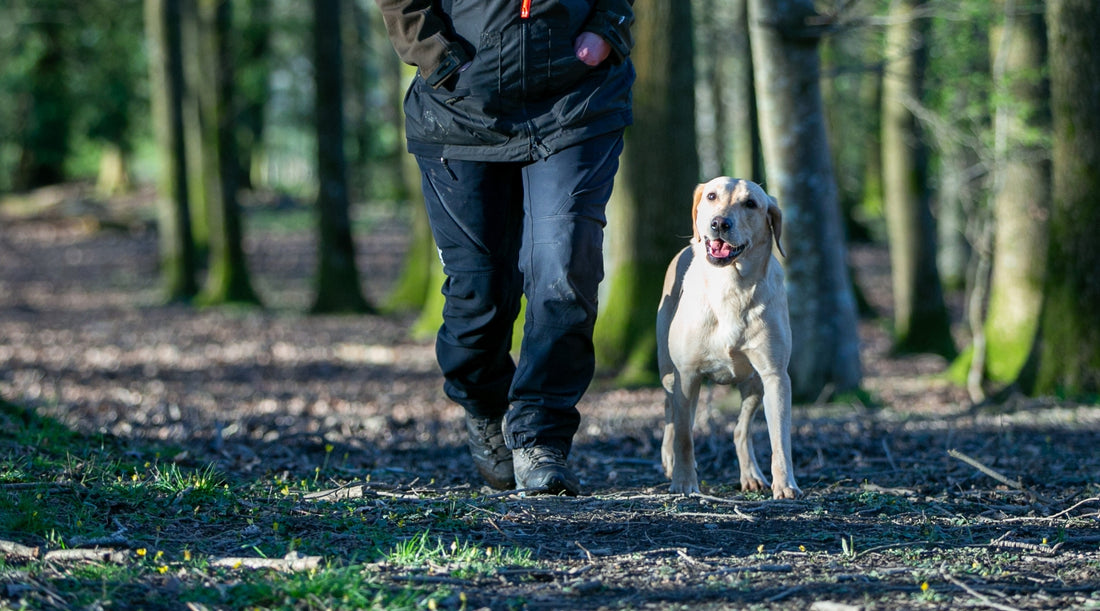How to stop my dog from pulling on the lead is one of the most common questions typed into Google or entered in an enquiries box on any dog trainer's website.
It is even more prevalent for those with gundog breeds, whose retrievers, spaniels, and HPRs view the daily walk as an opportunity to do what they were bred for: go hunting.
In this blog, we will discover why gundogs find walking at heel so difficult, what is expected of our dogs when we teach them heelwork, and how we can teach our puppies and older dogs to value being next to us.
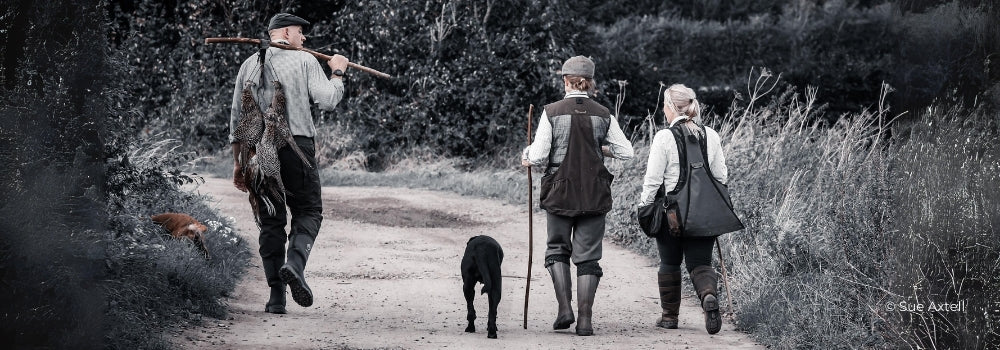
What is heelwork?
If you ask a dog trainer from a different dog sport or even another gundog trainer, you are likely to get several other interpretations of heelwork and what it should look like.
When we consider the different situations our gundogs face in the home environment, on a shoot, and in competition, it is difficult to quantify precisely what heelwork is.
When walking between drives on a shoot, your dog should be trotting along purposefully with you, neither hunting nor romping, but they might not necessarily need to be glued to your leg.
If you’re going on a casual walk to the pub in the evening, your dog might need to be on a lead, but you might want to allow them to sniff and pee on the way there.
In an assessment or competition, you will be required to keep your dog beside you, at shoulder level with your leg. They should match your pace exactly, be looking ahead and focused on work (ready to mark), no sniffing, no peeing, not looking up at you.
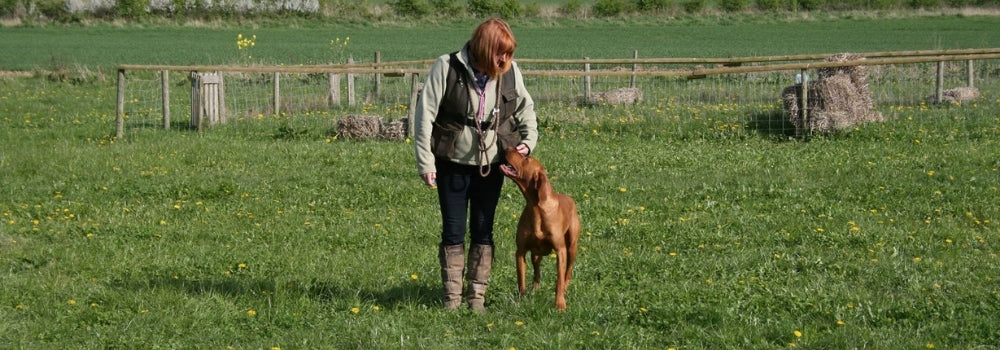
Why gundogs always want to be ahead of us?
Before we teach our gundogs to walk next to us at heel, it’s important to understand what’s going on in their brains and why they find the concept of matching our pace so challenging.
Firstly, we need to recognise that a walk is very self-rewarding for our gundogs. They can sniff scents, mark their territory, check where game has been and maybe even find and chase if they’re given the opportunity.
This gives them heaps of pleasure, which is why so many are eager to explore the environment as soon as they step a paw out of the house.
The other issue we face is that in nature, when a pack goes out to hunt, they are most in tune with each other, varying their pace to either keep up or drop back.
They are very aware of any slight changes in direction made by any member because the ability to react to purposeful changes in direction or speed could mean the difference between a successful kill and a failed hunt.
When left to their own devices, our dogs tend to meander, following their nose, stopping often, and their pace is much slower than ours.
When we pick up that pace by walking at our natural speed, our dogs assume this is because we are onto something, and they change their focus to intentional movement forward.
Here, our gundogs usually adopt a trot, moving in a nice, relaxed way but covering quite a distance at a reasonable speed. This is especially true for the HPR breeds, which are bred to range and cover long distances.
Our biggest problem as humans is that we do not move fast enough for our dogs in this scenario. We find it very difficult to match the speed of a loose trot, and even if we could, certainly, very few of us would enjoy maintaining it over a long distance.
We become at odds with our dog. Their idea of walking is too slow for us, but our idea of walking ignites their idea of purposeful forward movement, which is too quick for us.
Therefore, it is no surprise that our gundogs always want to be ahead of us. We must teach them how to adjust and compromise to match our desired pace, which requires great self-control and is a true measure of a dog’s ability to work cooperatively with its handler.

Can I teach my gundog to enjoy heelwork?
Biomechanically, walking to heel is jolly uncomfortable for a dog.
The natural walking gait for dogs is four beats: back right, front right, back left, and front left (or vice versa). However, they need to create a two-beat stride to match our walking speed.
One of the main mistakes handlers make when trying to teach their dogs to walk with them instead of rushing ahead or pulling on the lead is failing to give enough positive reinforcement.
This results in frustration from the dog, who feels mightily uncomfortable trying to adapt their pace, and a feeling of failure from the handler, who can’t figure out why their dog doesn’t want to walk with them.
You need to be patient and be prepared to pay your dog well for doing something that is most unnatural to them. Then, you need to keep up this reinforcement.
All too often, gundog owners ask, “When can I stop using food for heelwork?” Well, the answer is, “You don’t,” at least not entirely.
The rate of reinforcement and feedback can be adjusted so that you build up distance or the level of distraction, but for the behaviour to remain strong, it must be reinforced.
The key to helping your dog understand the heel position and enjoy spending time there is to begin with short sessions, a high rate of reinforcement, and frequent rest and play breaks.
Then, you can begin to plan your sessions to make gradual but actual progress rather than ‘drilling’ the same exercise, which is tiresome for you both.
Finally, you should never rush your training. There is a delicate balance here, and the onus is on you as the teacher to work this out with your own dog’s learning and understanding in mind. But you cannot expect a puppy or young dog to be able to walk at heel across open fields for an hour if they have only just mastered taking a few steps with you in the garden.
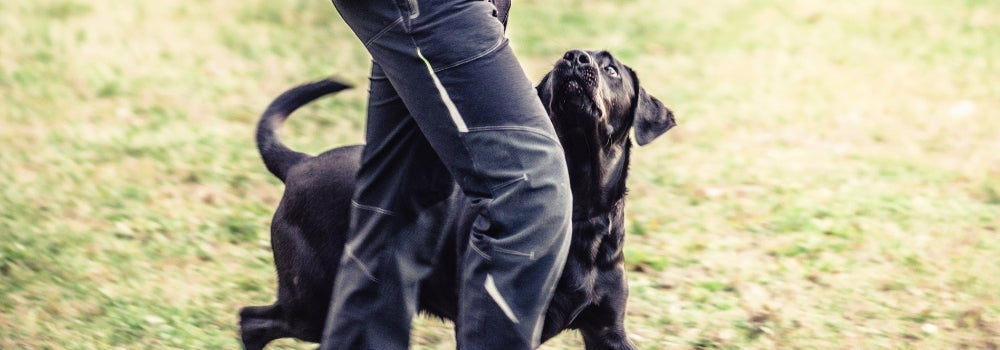
What is the “Catch Up” Game?
The “catch up” game is a fantastic method for creating value for the location of heel position and enabling the dog to work out what is required. It is particularly useful with young puppies as they naturally have a desire to stay with you.
Step one
Select a baseline environment with little or no distractions. If safe, take your dog off the lead and feed them just for being with you.
Step two
Place a piece of food on the floor beside the heel of your left foot and then walk off as your dog finds it.
Step three
Your dog will likely finish the food and come to seek you out. Click them as they catch up with you and place the next piece of food down as before. Repeat this several times making sure you move off straight after you have placed the food down.
Step four
You can adjust the timing of your click to occur as your dog commits to coming back to you. Then pay when they arrive at your side. If they go to the wrong side, don’t be tempted to change the food placement - you are building value for the location.
Step five
You can add changes of direction and speed at which you walk, but don’t run. You can also add a step or two of walking beside you before you pay. Always stop to feed; don’t feed while walking.
Step six
Once your dog is walking a couple of paces with you, add a slight turn and click the commitment to turn with you. You can then add stopping to this exercise - did they stop with you?
Step seven
Don’t be tempted to do great chunks of training in this exercise. Try to keep it fun and successful. The criteria you are aiming for is to build value for the heel location.
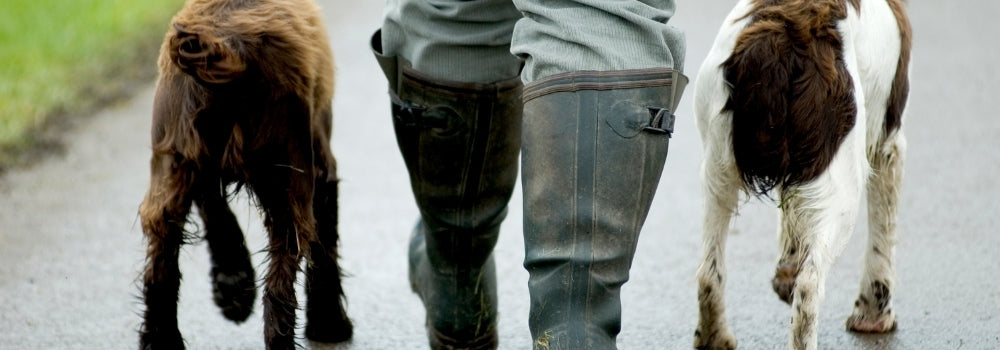
Heelwork Workshops with Lynsey
Whether you’re just starting with a puppy or are struggling with an older dog who always wants to be ahead of you and pulls on the lead, we can help you with your heelwork.
Suitable for all breeds of gundog, including retrievers, spaniels and HPRs, our two-part heelwork workshop will show you how to teach reliable off-lead heelwork that can withstand distractions and is suitable for assessments or tests.
In the two sessions, you will learn how to build a good connection with your dog, how to match pace, build duration and cope with the environmental distractions, plus how and when to add a cue, and then how to isolate the cue from everything else.
For more information and to book your place, please click here.

